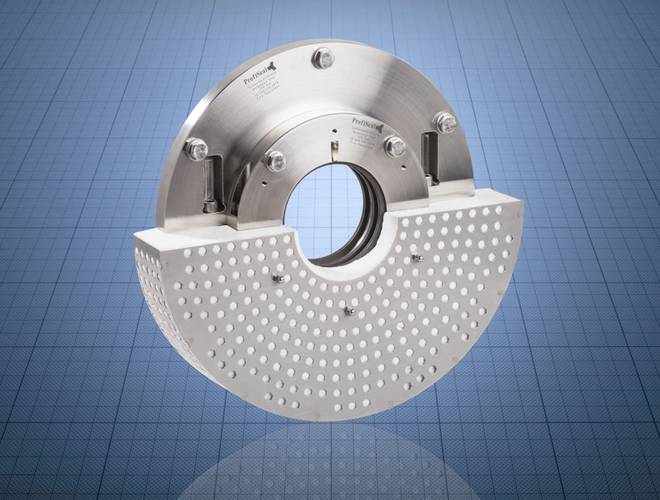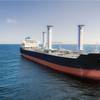Fireproof Bulkhead Seal from ProfiSeal
The world's first fireproof bulkhead seal for drive shafts on commercial, sea-going ships, megayachts and so-called special craft has come from Schornsheim in Rheinland-Pfalz (Germany). ProfiSeal, a company from the DEUTSCHE YACHTEN Working Group has now received type approval from the international classification society DNV GL for its innovation, which has been registered for patenting.
After a successful water pressure test, the special seal also demonstrated its resistance to fire (A60) over 60 minutes at 945 degrees Celsius.
In the event of an accident, bulkheads should not merely prevent water spreading through the entire hull after penetration. Neither should a fire in the engine room, for example, spread to other parts of the ship. Potential weak points are all passages, in particular those for dynamic components such as rotating shafts. Despite strict fire protection regulations as standard in the ship and yacht building industry, for example for rigid pipe and cable ducts, there has hitherto been no structural solution to this which can give all round satisfaction from an engineering perspective.
Profiseal's founder and owner, Hermann Aumüller (60), made the breakthrough with a triple arrangement of sealing rings. So far his proven dry-running, completely split gap seals for shafts from 50 to 400 millimetres in diameter, with two rings, located behind one another, with an allowed radial movement of ± 5 mm, hitherto minimised any water leaks.
In the event of a fire, the third, outer ring has now been "sacrificed". "With this quasi-controlled combustion, carbon dioxide is released, which protects both sealing rings to the rear, because the necessary oxygen for combustion is denied", explains Aumüller, an experienced electrical engineer who went into business for himself 20 years ago, producing stern tube seals for working vessels, public authorities craft and yachts.
This automatic fire extinguishing process is possible through the behaviour of the material used for split sealing rings, which consist of synthetic carbon, without the PTFE plastic additives otherwise used for standard seals. The most important basic property is primarily the good self-lubricating performance, because the seal is designed for sliding speeds of up to 40 metres per second. However, the "synthetic carbon" is heat-resistant in an oxygenated atmosphere only to about 500 degrees and with special impregnation up to 650 degrees – too low for approved fire resistance.
"The solution could lie only in the comparatively mundane chemical combustion reaction", according to Aumüller, a visionary, who has worked as a mechanic and developer in the avionics equipment industry. After he had the idea at the start of 2013, the first trials took place in the muffle furnace of "Schunk Kohlenstofftechnik", a specialist carbon manufacturing company in Gießen, Germany and were very promising. Further tests on ProfiSeal’s road to a worldwide innovation took place in the TU's Materials Testing Institution for Construction in Braunschweig.
However, the bulkhead seal endured its baptism of fire, in the truest sense of the word, in the testing oven of the Institute for Safety Engineering in Freiberg, near Dresden, internationally accredited for such fire tests. Here, the trial was set up at the end of March according to the 2010 FTP (Fire Test Procedure) code, with differing seal sizes, which initially covered sizes up to 400 mm shaft diameter. The computer-controlled oven heats to 945 degrees and brought the shaft ends protruding by half a metre from the bulkhead seal to white heat.
So that the housing did not transfer the high temperatures, the bulkhead seal itself was also clad and insulated against the heat with "Firemaster" insulating material also classified. Various sensors were used to measure and record the temperatures on the side of the bulkhead away from the fire. Within the testing period, heating of the sealing components was permitted by only 180 degrees Kelvin.
"The fire trial for this type of bulkhead seals was also new for us at DNV GL", said the engineer responsible for the test, Dr Dieter Krüger from Hamburg, "any breach of the safety-related rules of the classification societies are now excluded." ProfiSeal's bulkhead seals withstood this test with flying colours (with brilliant performance) for over an hour. The A60 prototype approval from the world's largest classification society, DNV GL (a merger of Det Norske Veritas and Germanischer Lloyd) cannot be long in forthcoming. Other international classification societies, such as the American Bureau of Shipping (ABS) have already signalled their recognition of the certification.
Although A60 fire-resistant bulkhead seals, strictly speaking, have been regulated for a long time, technical approaches to a solution were formerly costly and totally unsatisfactory, owing to their dependency on further fire protection systems. The innovative ProfiSeal can now take its place with immediate effect in the approval practice of the classification societies, in other words, it can be used as fully compliant. Not least, the insurance companies, as well as the International Convention for the Safety Of Life At Sea, SOLAS, should press for coupling and propeller shaft manufacturers to demand the component. ProfiSeal's four-man team in Schornsheim could start delivering in a few weeks.

















